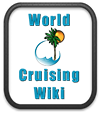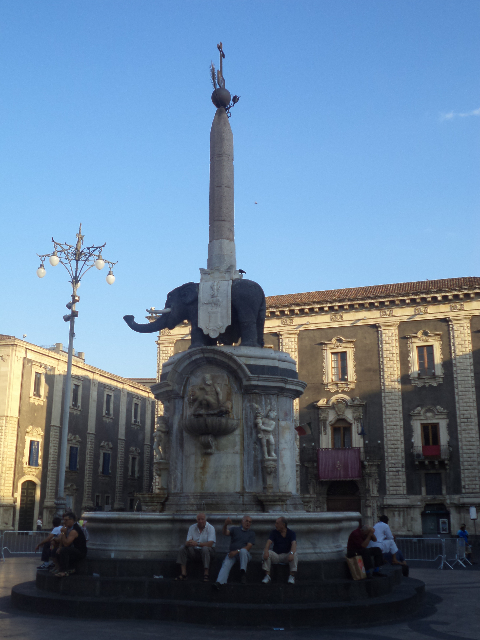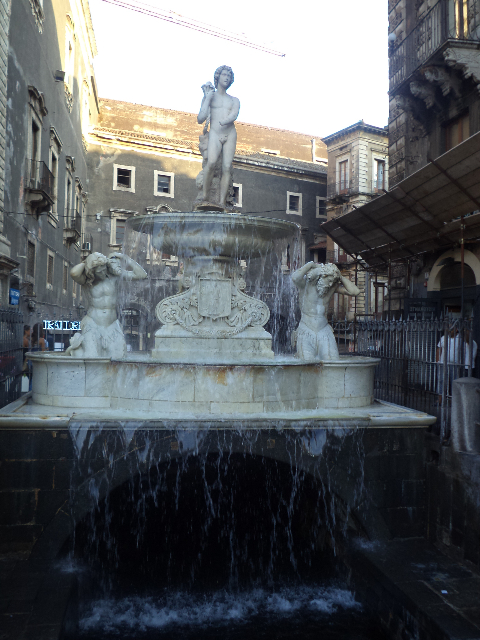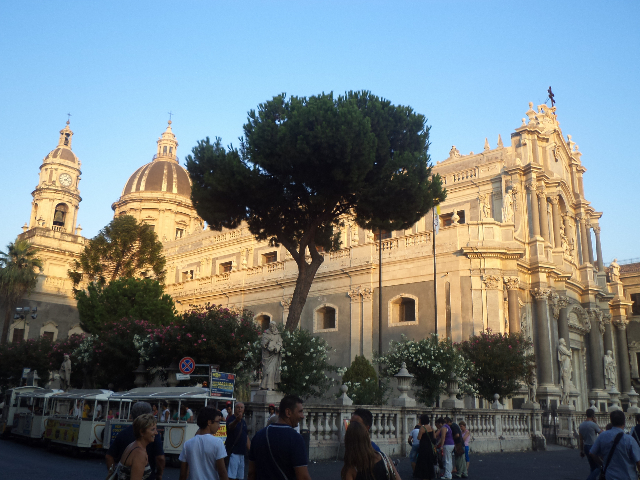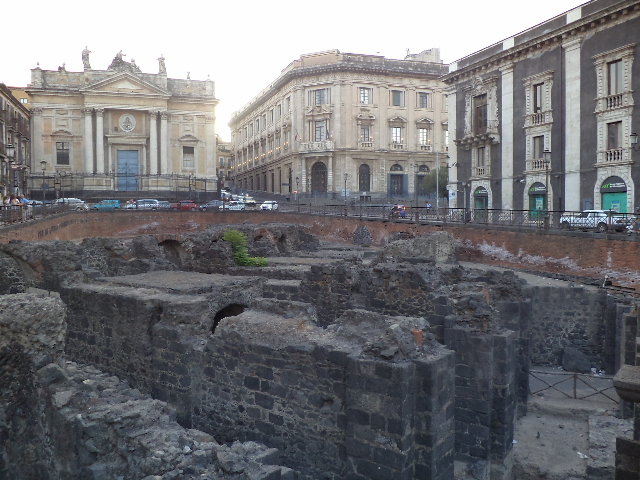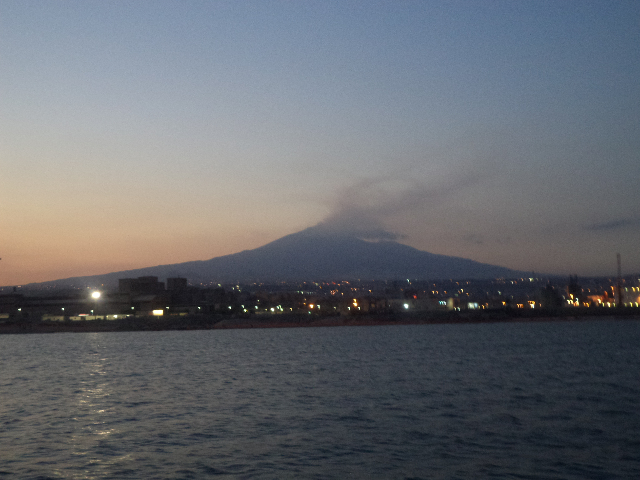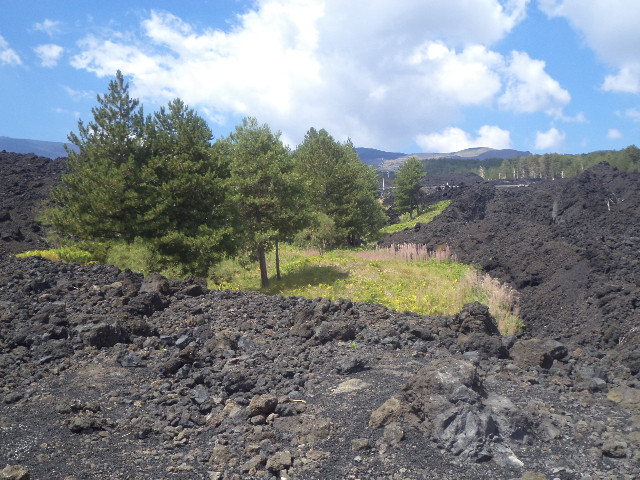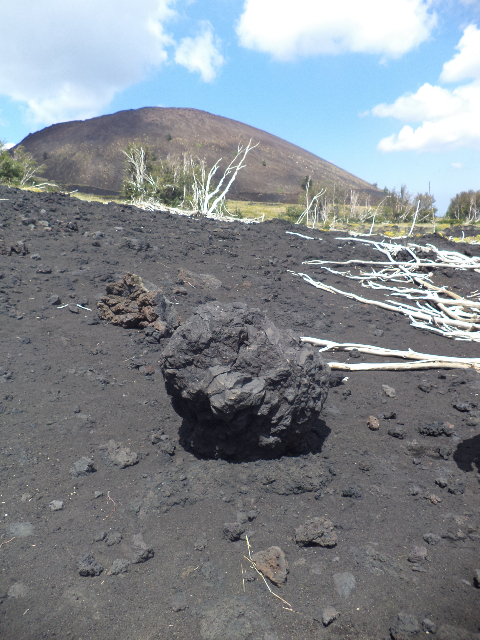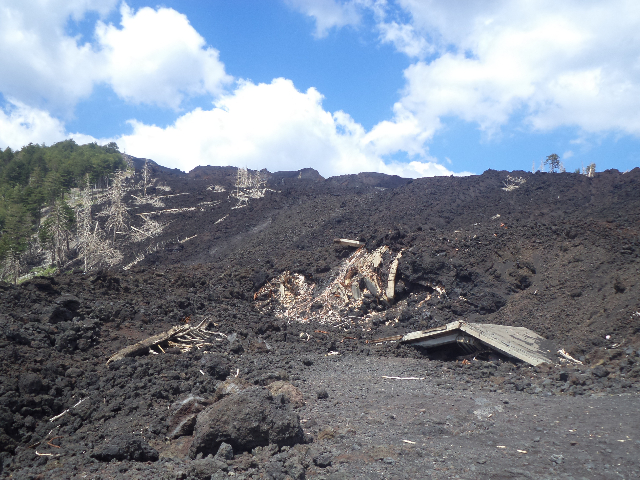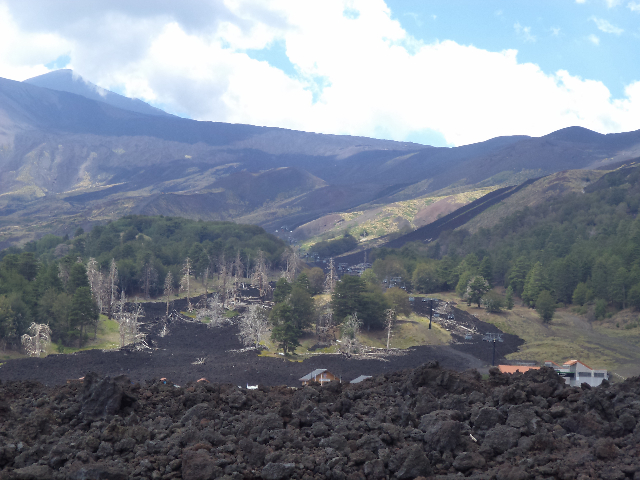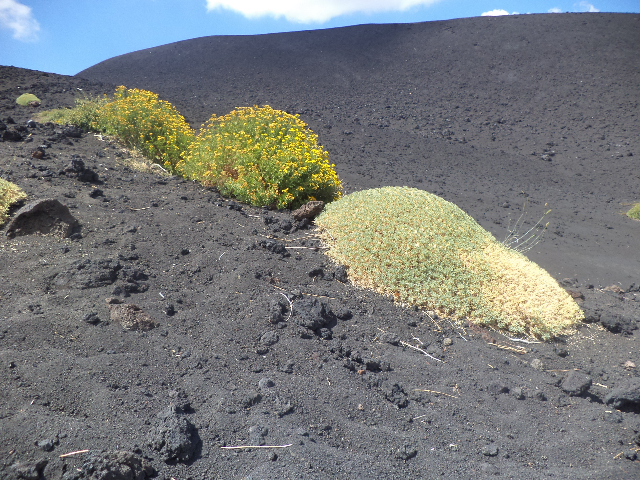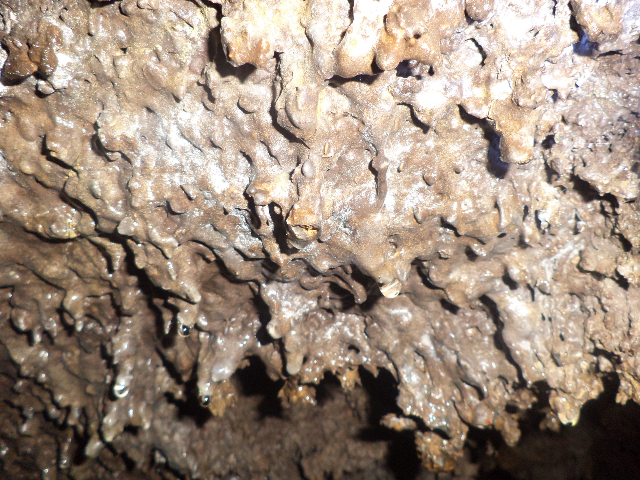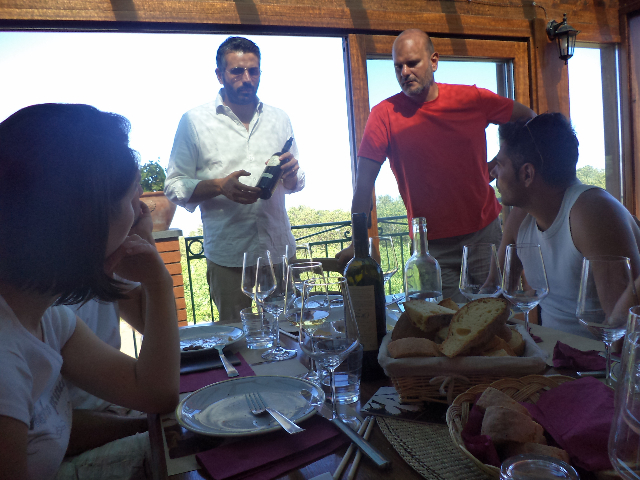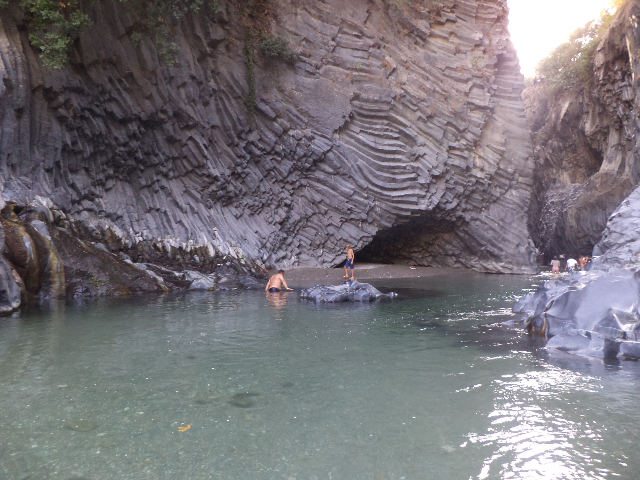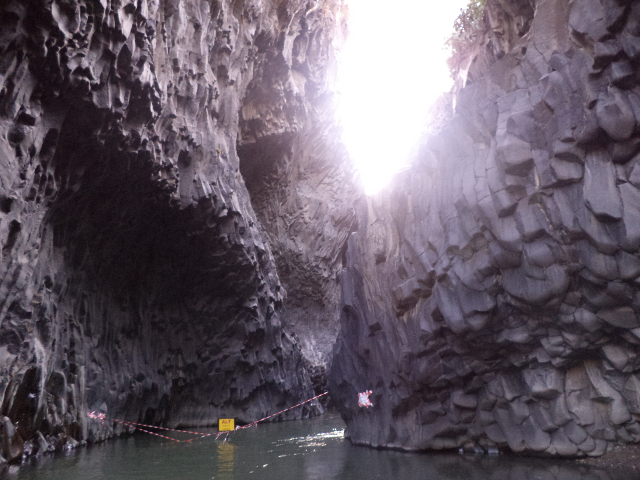Mt. Etna and Catania
Current Position: 37 29 N 015 5.43 E Click to view map.
Distance sailed since last post: 27 nautical miles. View the map of our voyage track here
From Syracuse we took a couple of days to sail and motor north to Catania, stopping to anchor at Augusta on the way. Nice anchorage, sheltered from most points apart from south and SW – but not sheltered from dozens of macho men and their planing machines, so it was a bit bumpy until the evening when they all went home.
Just north of Syracuse we passed a big tanker aground on the rocks! Ooops. Looking at the way it was lying, our theory is that it was at anchor during the storm that hit while we were still in Cagliari, and that it broke free and was driven onto the rocks. Otherwise I don’t see how someone could have driven it onto the rocks from that angle. Anyway, looks like salvage efforts are sort of underway, but I wonder what it will take to get it off the rocks again.
Catania is a big grimy city. The harbor is large and industrial, with a mix of ferries, cruise ships (presumably to do the Etna tour), fishing vessels and some yachts. The first night we anchored just outside the harbor entrance in 3m on sand. We were out of the way, but the next day the coast guard cam and told us to move. After looking north of the harbor, where they told us to go, we then returned to where we started, and just moved down the beach a couple of hundred yards. Less shelter from the harbor walls, but still satisfactory in the calm conditions.
Saturday had us touring the city by foot. There is a well equipped chandler just on the main street outside the harbor (turn left, it is on your right a few hundred meters down.) But they didn’t have any C-map cartridges and it was going to be 5 day to order them in. Having seen that our charts do cover the western Greek islands in the Ionian, we decided that we would cruise there for a few weeks, and then return to Ragusa for the winter. That way, we don’t need any new charts this year.
The town has, of course, the requisite number of ornate baroque churches and piazzas. But all the buildings are dark and dirty, and there is a lot of graffiti around. It looks run down and poor. But the people seem friendly enough.
On Sunday we went on an Etna tour. We travelled with Johnny, who runs “This is Etna” . They have only been operating since April, but already have impressive reviews on TripAdvisor. And they lived up to their billing.
Johnny picked us up in his big black Land Rover from the harbor entrance. We then picked up two other couples, one from Milan, the other from central Italy, Both spoke pretty good English, as did Johnny.
First stop was some crazy off-road driving with “Indiana” Johnny at the wheel. We pretty much drove across an old lava flow to view the Valle di Bose. Now, we have to get into a bit of geology here:
Sicily was formed at the junction of two tectonic plates – Europe and Africa. The north of Sicily is an extension of the Apennine mountains that run the whole length of Italy. The south was formed as the African plate was pushed under the northern plate.
In between the two, of course, is a fault line. Which is why the island sometimes has earthquakes. Those two plates, one on top of the other, float on magma – liquid rock full of high pressure gases, all under pressure like a pop bottle.
This pressure tries to find release, and does so through faults in the overlying plates. It is one such aperture that allowed Etna to form as a typical conical volcano many millennia ago. Initially the cone was at the south end of the island. Over time, however, the plates moved south while the volcano stayed static. Seen from the land, the volcano slowly marched north, forming the southeastern coastline as it did so.
But still it as a typical conical volcano.
Then, 9,000 years ago, the pressurized magma found a different passage through the rocks, and blew out the whole side of the volcano causing the world’s biggest tsunami with waves estimated to be 250m high!
That left behind a huge crater which, over the millennia, have been gradually filled with vegetation and forests.
Since then Etna has had countless eruptions. In fact, it is the world’s second most active volcano – the most recent eruption being just 2months ago, and another one expected at any time. Many of these eruptions occur from both the summit craters (there are now 4), or through the sides of the mountain (over 315 side craters at present).
Now, the good news is that much of the lava from these eruptions flows into this Valle di Bose and, as a result, protects Catania from receiving them. Even so, there have been some close calls, plus many villages that have been destroyed.
2002 is a good example. Etna gets winter snow, and so the government has built two ski resorts, which it rents out to operators. One night, at 3.30am, ski-tourists sleeping in the 54 bed hotel were woken up by a huge rumbling noise. They were hurriedly evacuated.
Half an hour later, a 26 km long crack developed in the ground, about half a mile away from the hotel. Through this crack, a whole series of new craters formed and erupted. Lava bombs flew up over 300m in the air, dropping to the ground at 600 deg C. Some of these were a meter in diameter. Ash and aerated rock fell all around. And lava flowed out.
The lava is hot – 1200 deg C. But it flows slowly, and so the surface cools and hardens. This forms a glassy crust to it, which breaks and crumbles as the lava relentlessly descends the hill. Because of the crust, the flow destroys only what it covers. Right next to it the trees and bushes are unharmed. But if it flows over your house, well, it is a good thing you got out. Which is just what happened to the 54 bed hotel that no is there no longer.
It takes ten years for the lava to fully cool down, so rebuilding has been slow. But gradually the ski hill is being rebuilt. It is odd to see the chair lift rising up over the black lava field.
We didn’t take the chair lift (for which they charge 54 euro per person!). Instead we hiked up to crack and some of the craters that formed from that 2002 eruption. It is, indeed, like walking on the moon. The black lava (the surface crust) is all aerated like an aero chocolate bar. The rock deeper down is solid black basalt.
In places the viscous lava, which contains bubbles of gases, rolls over itself and forms lava tubes, through which the lave then flows inside. In places, these bubbles open to the surface on one can walk into them. What is fascinating is the ceiling of the bubble as solidified drips of lava hanging down, like drips of melted chocolate off a spoon.
After a filling lunch of dried tomatoes, olives, salami, cheeses and bread – plus wine tasting of four different types of wine – we then went to explore the Alcatara gorge.
Here the river runs through a gorge of black basalt pipes – hexagonal columns of rock formed by rapid cooling of the lava.
The water was COLD – but we waded through it to take some cool pictures which, of course, never give justice to the live view.
Finally we drove home, arriving at Life Part 2 a full 12 hours after we left. A very good day out indeed, and well worth the 65 euro each (which included the food and wine).
From Syracuse we took a couple of days to sail and motor north to Catania, stopping to anchor at Augusta on the way. Nice anchorage, sheltered from most points apart from south and SW – but not sheltered from dozens of macho men and their planing machines, so it was a bit bumpy until the evening when they all went home.
Just north of Syracuse we passed a big tanker aground on the rocks! Ooops. Looking at the way it was lying, our theory is that it was at anchor during the storm that hit while we were still in Cagliari, and that it broke free and was driven onto the rocks. Otherwise I don’t see how someone could have driven it onto the rocks from that angle. Anyway, looks like salvage efforts are sort of underway, but I wonder what it will take to get it off the rocks again.
Catania is a big grimy city. The harbor is large and industrial, with a mix of ferries, cruise ships (presumably to do the Etna tour), fishing vessels and some yachts. The first night we anchored just outside the harbor entrance in 3m on sand. We were out of the way, but the next day the coast guard cam and told us to move. After looking north of the harbor, where they told us to go, we then returned to where we started, and just moved down the beach a couple of hundred yards. Less shelter from the harbor walls, but still satisfactory in the calm conditions.
Saturday had us touring the city by foot. There is a well equipped chandler just on the main street outside the harbor (turn left, it is on your right a few hundred meters down.) But they didn’t have any C-map cartridges and it was going to be 5 day to order them in. Having seen that our charts do cover the western Greek islands in the Ionian, we decided that we would cruise there for a few weeks, and then return to Ragusa for the winter. That way, we don’t need any new charts this year.
The town has, of course, the requisite number of ornate baroque churches and piazzas. But all the buildings are dark and dirty, and there is a lot of graffiti around. It looks run down and poor. But the people seem friendly enough.
On Sunday we went on an Etna tour. We travelled with Johnny, who runs “This is Etna” . They have only been operating since April, but already have impressive reviews on TripAdvisor. And they lived up to their billing.
Johnny picked us up in his big black Land Rover from the harbor entrance. We then picked up two other couples, one from Milan, the other from central Italy, Both spoke pretty good English, as did Johnny.
First stop was some crazy off-road driving with “Indiana” Johnny at the wheel. We pretty much drove across an old lava flow to view the Valle di Bose. Now, we have to get into a bit of geology here:
Sicily was formed at the junction of two tectonic plates – Europe and Africa. The north of Sicily is an extension of the Apennine mountains that run the whole length of Italy. The south was formed as the African plate was pushed under the northern plate.
In between the two, of course, is a fault line. Which is why the island sometimes has earthquakes. Those two plates, one on top of the other, float on magma – liquid rock full of high pressure gases, all under pressure like a pop bottle.
This pressure tries to find release, and does so through faults in the overlying plates. It is one such aperture that allowed Etna to form as a typical conical volcano many millennia ago. Initially the cone was at the south end of the island. Over time, however, the plates moved south while the volcano stayed static. Seen from the land, the volcano slowly marched north, forming the southeastern coastline as it did so.
But still it as a typical conical volcano.
Then, 9,000 years ago, the pressurized magma found a different passage through the rocks, and blew out the whole side of the volcano causing the world’s biggest tsunami with waves estimated to be 250m high!
That left behind a huge crater which, over the millennia, have been gradually filled with vegetation and forests.
Since then Etna has had countless eruptions. In fact, it is the world’s second most active volcano – the most recent eruption being just 2months ago, and another one expected at any time. Many of these eruptions occur from both the summit craters (there are now 4), or through the sides of the mountain (over 315 side craters at present).
Now, the good news is that much of the lava from these eruptions flows into this Valle di Bose and, as a result, protects Catania from receiving them. Even so, there have been some close calls, plus many villages that have been destroyed.
2002 is a good example. Etna gets winter snow, and so the government has built two ski resorts, which it rents out to operators. One night, at 3.30am, ski-tourists sleeping in the 54 bed hotel were woken up by a huge rumbling noise. They were hurriedly evacuated.
Half an hour later, a 26 km long crack developed in the ground, about half a mile away from the hotel. Through this crack, a whole series of new craters formed and erupted. Lava bombs flew up over 300m in the air, dropping to the ground at 600 deg C. Some of these were a meter in diameter. Ash and aerated rock fell all around. And lava flowed out.
The lava is hot – 1200 deg C. But it flows slowly, and so the surface cools and hardens. This forms a glassy crust to it, which breaks and crumbles as the lava relentlessly descends the hill. Because of the crust, the flow destroys only what it covers. Right next to it the trees and bushes are unharmed. But if it flows over your house, well, it is a good thing you got out. Which is just what happened to the 54 bed hotel that no is there no longer.
It takes ten years for the lava to fully cool down, so rebuilding has been slow. But gradually the ski hill is being rebuilt. It is odd to see the chair lift rising up over the black lava field.
We didn’t take the chair lift (for which they charge 54 euro per person!). Instead we hiked up to crack and some of the craters that formed from that 2002 eruption. It is, indeed, like walking on the moon. The black lava (the surface crust) is all aerated like an aero chocolate bar. The rock deeper down is solid black basalt.
In places the viscous lava, which contains bubbles of gases, rolls over itself and forms lava tubes, through which the lave then flows inside. In places, these bubbles open to the surface on one can walk into them. What is fascinating is the ceiling of the bubble as solidified drips of lava hanging down, like drips of melted chocolate off a spoon.
After a filling lunch of dried tomatoes, olives, salami, cheeses and bread – plus wine tasting of four different types of wine – we then went to explore the Alcatara gorge.
Here the river runs through a gorge of black basalt pipes – hexagonal columns of rock formed by rapid cooling of the lava.
The water was COLD – but we waded through it to take some cool pictures which, of course, never give justice to the live view.
Finally we drove home, arriving at Life Part 2 a full 12 hours after we left. A very good day out indeed, and well worth the 65 euro each (which included the food and wine).

